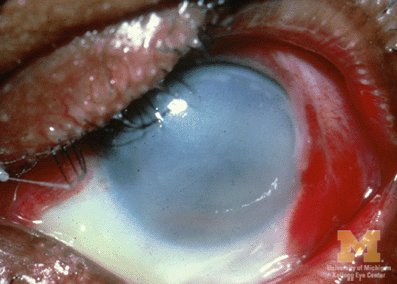Chemical Burn

- Damage to eye by contact with toxic chemical
- Symptoms usually temporary
- Alkali-containing compounds (household cleaning fluids, fertilizers pesticides) can cause enough damage to turn cornea opaque
- Acid-containing compounds (battery fluid, chemistry labs) cause less damage than alkali, but still dangerous
- History of chemical exposure
- In mild cases, pain, tearing, and conjunctival redness
- In severe cases, pain, tearing, cornea surface erosions, corneal opacification, and blanching of conjunctival vessels
- Instill topical anesthetic if patient will not open eyes because of pain
- Irrigate with handiest source of water for about 10-15 minutes (squeeze bottles or saline drip bottles)
- Use fingers, speculum, paper clip retractors to pry lids apart for best irrigation and removal of particles with cotton-tipped applicator
- Measure visual acuity
- Instill fluorescein dye to check for epithelial defects
- Refer to ophthalmologist if acuity is subnormal, or there are epithelial defects
- Most chemical burns leave no harm
- Alkali (and acid) burns may cause permanent corneal damage
- Early irrigation helps
- In badly damaged eyes, specialized ophthalmologic treatment may be necessary, including corneal transplantation with special (Boston) keratoprosthesis
